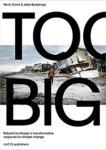“Too Big”–Inside an Extraordinary Effort to Cope with Climate Change

Henk Ovink thinks different. You realize that after just a few minutes of talking with him. Or by hearing some of his job titles: Sherpa for the UN Commission High Level Panel on Water, Netherlands' first Special Envoy for International Water Affairs. Or by looking at the photo of him standing fully dressed in a swimming pool (for a news profile).
A Dutch urban planner, Ovink came to the U.S.--a volunteer on loan from the Dutch government--to help rebuild New York City after Hurricane Sandy. His approach was . . . different. With the crucial buy-in of Shaun Donovan, then-head of the federal Department of Housing and Urban Development and the help of many partners, Ovink designed and ran a unique Rebuild By Design (RBD) process. RBD fostered a massive, intense collaboration-competition among communities, local, state, and federal governments, and design teams of professionals from around the globe that resulted in the development of seven world-class projects to boost the NYC region's resilience and attracted about $1 billion in federal investment. Now, with Jelte Boeijenga and interviews with a dozen partners, Ovink tells the inside story of the process and what was radically different about it: Too Big: Rebuild By Design: A Transformative Approach to Climate Change.
 In "Too Big," Ovink explains that the complexities of climate change--the "new normal"--require a new approach that "steps outside existing frameworks and agreements based on assumptions made in the past. . . We must free ourselves of too common 'cannot,' 'must not' and 'won't work' attitudes and embrace a 'yes, we can' mentality. That, in turn, means we must set aside accepted roles and challenge longstanding relationships. We need coordination between the analysis of challenges and real understandings of them, developing a comprehensive perspective that connects us to immediate action and immediate impact. in other words, we need truly inclusive collaboration that ties everyone and everything, from the first day to the last, into a new working culture."
In "Too Big," Ovink explains that the complexities of climate change--the "new normal"--require a new approach that "steps outside existing frameworks and agreements based on assumptions made in the past. . . We must free ourselves of too common 'cannot,' 'must not' and 'won't work' attitudes and embrace a 'yes, we can' mentality. That, in turn, means we must set aside accepted roles and challenge longstanding relationships. We need coordination between the analysis of challenges and real understandings of them, developing a comprehensive perspective that connects us to immediate action and immediate impact. in other words, we need truly inclusive collaboration that ties everyone and everything, from the first day to the last, into a new working culture."
Ovink's tale about how this was mostly accomplished, although not without great difficulty, in the midst of an enormous urban disaster--using a design process to "make a conscious detour around the sometimes rigid and ineffective ways that government and the whole of society works"--offers a series of lessons that other cities and national governments have already been using and that can help urban climate adaptation practitioners everywhere get further, faster, better.
Photo credit: Olivia Locher for The New York Times


